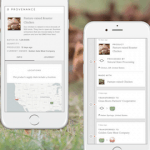Scaling Climate Finance for Smallholder Agriculture: Lessons Learned from Partnering with Farmer-Allied Businesses
Small-scale agriculture is the lifeblood of rural communities around the world, supporting the livelihoods of more than 600 million farming families and generating over 40% of jobs in Asia and sub-Saharan Africa. Yet agricultural livelihoods are highly vulnerable to climate change. Rising temperatures and changing precipitation patterns reduce crop yields and increase poverty. Climate shocks like extreme droughts, flooding or super hurricanes can destroy farms and lives and lead to forced migration. Without action, climate change is expected to push up to 130 million people into poverty by 2030.
Smallholder farmers urgently need financing to prepare for climate change and build resilient livelihoods. Yet while 95% of the world’s farms are small-scale, they receive a mere 1.7% of global climate financing. Small deal sizes, high transaction costs and high risk relative to other sectors already limit the flow of capital to smallholder agriculture. Increasing risk and uncertainty tied to climate change only compound this longstanding market failure, with potentially devastating consequences for vulnerable communities. New analysis shows we need at least a sevenfold increase in climate finance for agricultural systems to prepare for the new climate reality.
Over the last three years, Root Capital has worked to help close the climate finance gap for small-scale agriculture. At Root Capital, we partner with farmer-allied enterprises in low- and middle-income countries to improve rural livelihoods. These businesses provide otherwise-marginalized smallholder farmers with a range of benefits, like access to high-value markets for their crops, agricultural training and micro-loans. Under our Climate Resilience Roadmap, we provide businesses with the management skills, data and capital needed to confront the climate crisis head-on. This includes new climate finance products tailored to the needs and aspirations of small businesses and farmers.
Over the last three years, we’ve provided almost $3 million in climate finance to 42 businesses supporting 100,000 farmers managing 80,000 hectares of farmland. Here’s what we’ve learned so far about how to design and scale climate financing for smallholder communities.
Lesson 1: Look to local communities to set the agenda
Climate risks, and therefore climate solutions, are highly localized. Even within one crop, such as coffee, farmers and businesses in different geographies face different climate threats — ranging from excessive rains and landslides in Peru and Rwanda, to heat waves and drought in Honduras and Nicaragua — as well as different opportunities. There is no one-size-fits-all climate solution or climate finance product.
To effectively address the climate crisis, local communities must lead the way in defining priorities for climate action. To that end, farmers and businesses are already taking action, and they’re seeking to take more. As one business manager told us last year, “You cannot talk about our coffee business without talking about climate change. … If we don’t address climate change, we will lose a significant portion of our business.” It’s up to investors to listen to these concerns and develop relevant, right-sized financing solutions.
To inform our own climate finance offering, Root Capital surveyed over 90 farmer-allied businesses in Africa, Asia and Latin America on their climate action priorities. (We thank Bain & Company for their generous support in conducting this work.) We found that 93% of these businesses had already invested in some kind of climate action over the last three years, namely climate-smart training or inputs for farmers, reforestation, or increasing the energy or water efficiency of their operations. And 97% planned to invest more in the next three years.
But businesses also cited constraints in realizing their climate ambitions: first and foremost, limited access to external financing for climate-related investments. Businesses financed about 60% of past climate investments solely from internal funds, essentially from surplus business revenue when available. The average business investment was relatively small: $150,000 per year, for businesses reaching 3,000 farmers on average. But when these businesses were able to access external financing, they spent two to three times more on climate action.
Informed by this data from our partners, Root Capital prioritized three climate solutions for our climate finance offering: resilient farm management, especially support for agroforestry and regenerative soil management practices; business nurseries for climate-resilient crops and shade trees; and climate-smart business infrastructure. Within this global strategy, however, we established different regional priorities based on feedback from our partners. We found that coffee businesses in Central America, for example, are most interested in loans for regenerative soil management, while those in East Africa wish to scale tree nurseries to combat erosion and other challenges. Our experience underscores the importance of not imposing top-down solutions, but rather following the lead of front-line communities.
Lesson 2: Offer capacity building to unlock climate finance opportunities
As a business trainer and lender, Root Capital has seen the importance of capacity building in preparing small-and-growing agricultural businesses for financing. Capacity building is especially important when it comes to climate financing, given the technical or innovative nature of many climate investments. In fact, in the survey mentioned above, our partners cited limited technical capacity as the second most important barrier to scaling climate action (after lack of financing).
Recognizing this reality, Root Capital provides farmer-allied businesses with tailored advisory services to build their business knowledge and capacity to address climate change, both now and into the future, as climate risks evolve. These advisory services usually start with a diagnostic of a business’ vulnerability to climate change, informed by data on local climate risks from our partner the Alliance of Bioversity International and CIAT. From there, Root Capital advisers help businesses create climate adaptation plans, including climate-smart training and inputs for farmers.
For example, prior to Root Capital’s support, some of our business partners provided farmers with “one-size-fits-all” fertilizer recommendations rather than individual recommendations based on the specific needs of their soils — with negative implications for soil health, crop yields, and ultimately farmer income and resilience. To address this, our advisory team helps businesses conduct and interpret soil analyses to create data-driven fertilization plans designed to regenerate farmers’ soil.
We’ve seen that advisory services can drive the uptake of climate financing by helping businesses identify or sharpen their climate action priorities. After businesses develop climate-smart fertilization plans, for example, Root Capital can provide loans to make them a reality. To date, over 75% of our climate action loans have been informed by Root Capital advisory services.
Lesson 3: Make climate action affordable for smallholder communities
When it comes to scaling climate action for smallholder agriculture, the conversation often focuses on the supply side: How much climate finance is flowing to smallholder farmers, their business allies and the larger food system — and how much more is needed? But while the supply side, of course, is critical, we as investors cannot forget the demand side of the equation: What kinds of finance do farmers and businesses want, on what terms and at what price?
And while the immediate threat of climate change is clear, the short-term economic returns of specific climate investments may not be. Some climate investments pay for themselves by generating new revenue, perhaps in the form of increased crop yields or quality — but it may take years to see results. Others generate value primarily by reducing future risk — for example, reducing the risk of crop losses due to droughts — but reduced risk does not put new cash into the hands of farmers or agricultural businesses. Understandably, small farmers and businesses can be reluctant to invest in climate action, given limited cash reserves, market volatility, and other livelihood or business priorities.
Blended finance can play a transformative role in making climate investments more affordable, and therefore more accessible, for small-scale agricultural supply chains. Across all our lending, Root Capital strategically blends philanthropic and investment capital to sustainably serve farmer-allied businesses excluded from commercial financial markets. Within our climate finance offering, we deploy additional philanthropy to make climate action more affordable for smallholder communities.
First, we offer small grants to develop proof-of-concept for climate actions less familiar to businesses or farmers. For example, in Kenya, we partner with Sistema.bio to provide biodigesters to farmers working with macadamia processing businesses. Farmers want biodigesters because they generate clean energy and organic fertilizer, but they often lack the cash to pay for the units outright. With a $20,000 grant from Root Capital, a macadamia business can buy dozens of biodigesters and “on-lend” them to farmers, collecting the payments during future harvest cycles. When repaid, these businesses can recycle the grant funding to reach the next batch of farmers — or apply for a larger loan from Root Capital to scale the technology across the thousands of farmers in their supply chains.
Second, we offer businesses discounted interest rates for climate action loans. As discussed above, investments in climate adaptation and resilience may not generate a significant, immediate income boost for farmers or businesses, as their benefits often stem from reduced losses from future climate shocks. This makes it difficult for businesses to cover the interest and fees normally associated with a loan, so we discount our rates to keep loans affordable. Reducing interest rates means we will lose money, at least initially, on many climate loans. We’re able to offer this discount thanks to the generous support of our funding partners. And we see a path toward greater financial sustainability: If businesses scale their climate investments, the loan sizes will grow, and we will cover our costs even with the reduced interest rate.
Looking Ahead
Root Capital sees enormous opportunity for farmer-allied businesses to serve as partners in scaling locally-determined climate action around the globe. These businesses have a deep understanding of farmer realities and aspirations, they are invested for the long term, and they are developing creative solutions to the climate crisis. If we, the global climate finance community, can get them the resources they need, they will drive real, sustainable change on the ground.
Looking ahead, Root Capital seeks to expand our climate financing to reach more businesses and more farmers. Closing the climate finance gap for small-scale farmers and supply chains requires collaboration and knowledge-sharing among various stakeholders. Root Capital could not do this work without partners ranging from climate technology providers and climate researchers, to investors and donors. We thank our existing partners, and we look forward to learning from others who are innovating climate financial solutions for small-scale agriculture.
Elizabeth Teague is a Senior Director of Climate Resilience at Root Capital.
Photo courtesy of Climate Change, Agriculture and Food Security.
- Categories
- Agriculture, Environment, Investing



